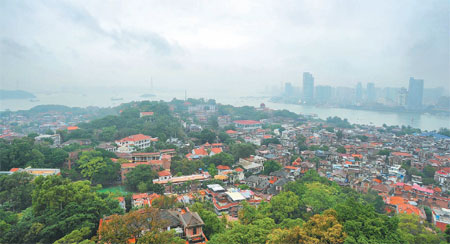City with beauty and age
Updated: 2013-01-27 08:30
By Mike Peters (China Daily)
|
|||||||||||
|
A scenic view of Xiamen from Gulangyu islet, where European architecture attracts visitors to its "pedestrians only" streets. Mai Tian / for China Daily |
|
The Piano Museum features more than a hundred instruments of historic interest from around the world. Zhang Heping / for China Daily |
It was one of the treaty ports established after the First Opium War, but Xiamen has put aside its history to take its place among China's major cities. Mike Peters finds out the latest attractions.
Egret Island. Island of Abundant Crops. Gateway to China. Amoy. Siming ("Remember the Ming"). Few cities can boast a more colorful series of names - and a history to match - than Xiamen. Legend has it that egrets and poisonous snakes once battled for supremacy here. The birds won, which is why tourists can enjoy a view of Egret Island, and why the egret's silhouette adorns the logos of many local businesses.
Xiamen's story includes plenty of battles among humans, too. Staring out over the harbor is a massive statue of Zheng Chenggong (1624-1662), the national hero popularly known in the West as Koxinga.
Xiamen was one of the five treaty ports established in 1843 after the First Opium War, which made the city - especially the islet of Gulangyu - a place of colonial architecture. The old German consulate is just one of the fine old residences that have been refurbished to welcome overnight travelers.
Today Xiamen is a haven of tranquility - and a semi-tropical escape with special allure as winter's icy grip squeezes the northern half of China. Locals describe Xiamen's appeal as if reciting the Goldilocks and the Three Bears fairy tale: It's not too big and not too small.
"Xiamen is one of the most beautiful cities in China and, located by the sea, it has great views," says Duan Yulin, a local policeman who moved there from Hunan province about eight years ago. He does not like huge cities but also dislikes the inconvenience of small places. "Xiamen is just about the right size," he says.
"I hear people debating whether this is a second-tier or a third-tier city," says Martin Verpoorten, general manager of the new Westin Xiamen, the latest high-end hotel to open its doors on the island.
"This market is not saturated," Verpoorten says. While there are plenty of options in the city center, he adds, new hotels will open on the north side of the island as trade across the Taiwan Straits grows rapidly.
Verpoorten worked in Sanya in the past and says Xiamen has an edge over that sun-and-fun destination. "On Hainan Island, when you're done at the beach, there's not much to do. Here, a lively city awaits."
Entertainment options include an intriguing jade museum, where a terrific English-speaking guide showed us everything from dainty miniatures to a massive jade head with bulging square eyes.
You can stroll and eat your way along Taiwan Food Street, one of several lanes with enticing local delicacies, starting with hot-off-the-grill oysters bubbling with garlic, chopped tomato and sea salt.
You'll find tea "shops" that have brewed regionally grown leaves in the same ceramic vessels for a century. Fujian province is China's main producer of the famed oolong teas.
Laid-back vendors will slice off servings from jackfruits the size of a wall safe, and rose apples - those hot-pink, bell-shaped fruits - are offered three on a stick for about 5 yuan (80 cents).
There's a strong bar and restaurant scene, too, but skip the guidebook-touted Guanren Road Bar Street - a shadow of its once-lively self - and head for the new hotspot: the waterfront strip at Haiwan Park.
Popular hangouts there include the Me & You 2 Bar & Pizza Co, the Havana Bar, JJ's Texas and Steve's, all with live music from spot-on Filipino cover bands. We also liked the food, cigars and music at the Westin's Cuba-themed Qba, where a lively live band from Havana plays six nights a week.
Culture vultures shouldn't miss the Nanputuo Temple, first constructed during Tang Dynasty (AD 618-907). The nearby vegetarian restaurant Dafang Sucaiguan is nearly as famous as the temple itself among the patrons, with dishes that are colorful, tasty and poetically named.
Xiamen University, colloquially known as Xia Da, is the first university in China founded by overseas Chinese in 1921. Backed by green hills and fronted by the sea, its elegant architecture and tree-lined streets make it a treat to explore the grounds on foot.
And then there's that must-do daytrip to Gulangyu islet, a 10-minute ferry ride away. Shuzhuang Garden includes a pleasant bathing beach and the Piano Museum, which features more than a hundred instruments of historic interest from around the world.
Under the influences of European missionaries, the piano has long been popular among locals - one out of every three residences is said to have one - and the island also boasts a famous music college and an organ museum.
Daytrips often turn into overnighters on the islet, and hundreds of beds are available in "home-stay hostels". Some are fully operating bed-and-breakfasts, while others may simply be a bedroom in a busy multi-family dwelling. But even the latter are generally pleasantly renovated with Western-style plumbing and an ambience from bygone days.
Today's Top News
Police continue manhunt for 2nd bombing suspect
H7N9 flu transmission studied
8% growth predicted for Q2
Nuke reactor gets foreign contract
First couple on Time's list of most influential
'Green' awareness levels drop in Beijing
Palace Museum spruces up
Trading channels 'need to broaden'
Hot Topics
Lunar probe , China growth forecasts, Emission rules get tougher, China seen through 'colored lens', International board,
Editor's Picks

|

|

|

|

|

|







